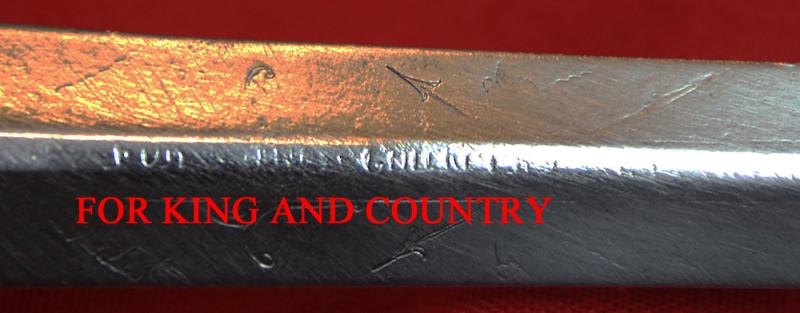A Most Beautiful & Elegant Sword. 1780's to the Battle of Waterloo, British Silver Bound Hilted Steel Spadroon Officer's Sword, Used From The American Revolutionary War Until the Close Of The Napoleonic Wars at Waterloo 1815. Engraved For King & Country
Adam urn pommel silver multi-wired grip of superb quality, D hilt with single quillon, with straight double-edged blade of flattened-diamond section, engraved with the crowned Royal arms, trophies, foliage and 'For King and Country' (worn),
We are offering a few Waterloo battle site recoveries alongside the farm’s cast iron fireback and some other relic items of combat, such as soldiers thimbles, plus grenades, cannon balls etc. discovered around La Haye Sainte. Plus, weaponry and items that were part of the Cotton Collection at the Waterloo Museum on the Waterloo battle site that were sold in 1909 at auction.
La Haye Sainte (named either after Jesus Christ's crown of thorns or a bramble hedge round a field nearby), is a walled farmhouse compound at the foot of an escarpment on the Charleroi-Brussels road in Belgium. It has changed very little since it played a crucial part in the Battle of Waterloo on 18 June 1815.
La Haye Sainte was defended by about 400 King's German Legion troops during the Battle of Waterloo. They were hopelessly outnumbered by attacking French troops but held out until the late afternoon when they retired because their ammunition had run out. If Napoleon Bonaparte's army had captured La Haye Sainte earlier in the day, almost certainly he would have broken through the allied centre and defeated the Duke of Wellington's army.
The capture of La Haye Sainte in the early evening then gave the French the advantage of a defensible position from which to launch a potentially decisive attack on the Allied centre. However, Napoleon was too late—by this time, Blücher and the Prussian army had arrived on the battlefield and the outnumbered French army was defeated.
Strategic importance
A view of the battlefield from the Lion's mound. On the top right are the buildings of La Haye Sainte. This view looks east, with Allied forces behind the road to the left (north) and French forces out of shot to the right(south)
The road leads from La Belle Alliance, where Napoleon had his headquarters on the morning of the battle, through where the centre of the French front line was located, to a crossroads on the ridge which is at the top of the escarpment and then on to Brussels. The Duke of Wellington placed the majority of his forces on either side of the Brussels road behind the ridge on the Brussels side. This kept most of his forces out of sight of the French artillery.
A spadroon is a light sword with a straight-edged blade, enabling both cut and thrust attacks. This English term first came into use in the early 18th century, though the type of sword it referred to was in common usage during the late 17th century. They were primarily used as a military (army & navy) sidearm in the late 17th and early 18th centuries, and for officers in the latter part of the 18th and early 19th centuries. The type of sword also saw widespread use across Europe and America, though the term 'spadroon' is unique to the Anglophone world.
Spadroon is a term used to categorise a type of sword that is in between a small sword (which thrusts only), and the heavier-bladed broadsword.
1786 regulation
A hugely significant year for the sword and specifically the spadroon, in army service, was 1786, as it saw the end of pole arms for officers, and the introduction of the first standard for a sword, the 1786 pattern. Though it may be called that today, it was not in fact a pattern at all. 'Pattern' refers to a piece of example equipment that has been accepted for army service. Since the start of the eighteenth century a band of officers (or other responsible persons) has approved the quality and finish of all items of military clothing, it was then sealed with the wax of the Board of Ordnance or other Government (wax) seal to be recognised as the standard to be kept by manufacturers. This allowed manufacturers, tailors, and swordsmiths to have an example to use as a reference for both design and quality. The 1786 sword was not a pattern, but a rather vague description. Nonetheless it was the first standard outlined for army wide service, and so is commonly referred to as the 1786 pattern today but might be better described as the 1786 regulation.
The Spadroon is a key weapon in the study of British military swordsmanship of the Napoleonic period, as well as those practising from earlier 18th century British sources. It was one of three main weapons outlined in the key works of swordsmanship in that period, such as Charles Roworth's 1798 manual, 'The Art of Defence on Foot, with Broadsword and Sabre...to which are added Remarks on the Spadroon'. A number of Historical Fencing, or HEMA clubs around the world are now pursuing modern day practice of the spadroon.
Cotton Collection exhibit sword, used at Waterloo
No scabbard
Code: 25035
825.00 GBP










